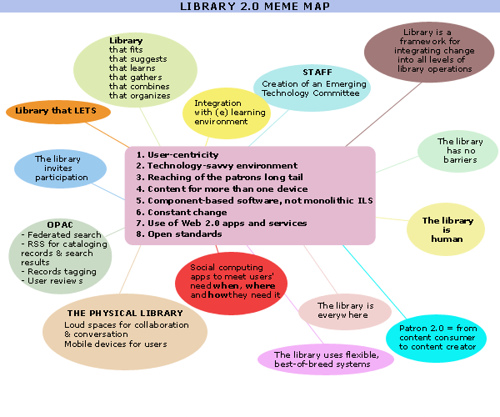To get somewhere, you have to be able to imagine where you are going.
On her blog, Information wants to be Free, Meredith Farkas suggests:
“Maybe it would make sense to be asking the miracle question in our libraries. If a miracle occured(sic) one night and all of the problems with your library were gone (or we miraculously reached library 2.0 overnight), how would you know that a miracle had occurred? What would be different? What would the library be like?
Once you have that vision for what your library/Library 2.0 should look like, what specific steps do you and your colleagues need to take to get there (how do you get to 1.3, 1.6, etc.)? Once you have your answer to those questions, you should have a clear roadmap for reaching your goal.”
Bonaria Biancu created an insightful model of what library 2.0 might look like:
Notice the emphasis on removing barriers to use, being invitational, and creating spaces for collaboration. In addition, the library is available everywhere, not just in a defined space or time. And the patron is not just as a user of information, but a participant and content creator.
Darlene Fichter questions even this notion of a patron, pointing to Jay Rosen’s article on “The people formerly known as the audience.” Read the whole thing if you haven’t already–really brilliant ideas for both teachers and librarians. A few excerpts:
“Think of passengers on your ship who got a boat of their own. The writing readers. The viewers who picked up a camera. The formerly atomized listeners who with modest effort can connect with each other and gain the means to speak— to the world, as it were. . . .”
Rosen cites both Tom Curley, CEO of the AP and Mark Thompson of the BBC:
“. . .We’re not on your clock any more. ‘The users are deciding what the point of their engagement will be — what application, what device, what time, what place’. . . .Mark Thompson, director general of the BBC, has a term for us: The Active Audience.”
and finally,
The people formerly known as the audience are simply the public made realer, less fictional, more able, less predictable.
Fichter noticed that Andy Carvin carried this idea into his presentation at Computers in Libraries, calling library customers the “people formerly known as patrons.”
So her visual for a web 2.0 library mission incorporates that idea of trust and respect for the “people” (in this case our students):
She challenges us:
“We can only build emergent systems if we have radical trust. With an emergent system, we build something without setting in stone what it will be or trying to control all that it will be. We allow and encourage participants to shape and sculpt and be co-creators of the system. . . .
Radical trust is about trusting the community. We know that abuse can happen, but we trust (radically) that the community and participation will work. In the real world, we know that vandalism happens but we still put art and sculpture up in our parks. As an online community we come up with safeguards or mechanisms that help keep open contribution and participation working.”
Even as we seek in schools and libraries and classrooms to connect our students and to create conditions for collaboration, are they still the audience, more often than not?
And in thinking about how to put this into practice in a school library(or a classroom)–
–How can we ask students to participate and create content for our libraries? Do we have library blogs for students? Do we, as Joyce Valenza does, set up wikis for pathfinders and invite teachers and students to add the links to them? (By the way, look at her incredibly student friendly website.)
–Can students help define our policies for our libraries or classrooms? One of our elementary librarians has a library council which helps govern her library. I’ve seen wikis used to define web 2.0 policies that were created with student input.
–Can students create our library displays in our physical space? We tried this last year–setting up an empty table and asking students to create the display. (and imagine doing this online….?)
–Can students initiate programs we are holding in our schools or libraries–forming a panel who helps select the guest speakers?
–Do we survey students about our renovations, collections, services? Do we have a suggestion box in our classrooms or libraries or on our websites?
–Do students and teachers help select our books and media? In the classroom, do they help select our reading lists?
–How do we use web 2.0 tools to help build community? Do our library catalogs(or teacher websites) allow reader feedback(like Amazon?) If not, do we have a place where students/teachers can provide that feedback? And why aren’t we asking our library vendors to add such a thing to their software?
–Do we make ourselves “available” 24/7 outside the classroom? Are our catalogs available for home use? Do we have an “email the librarian” (or email the teacher) feature on our website, or a chat box, or a skype button, or a way a student, parent, or teacher, can easily leave us a message or question?
As we seek to redefine what our libraries and schools and classrooms can be, envisioning what our “miracle” looks like will help us reshape our practice.
Thanks to Jenny Levine and Michael Stephens, for creating the Library 2.0 reading list from ALA where I found many of these links.
Happy Global Library 2.0 Week. I’m planning to “leave the grid” for a few days and seek drier weather. Keep your comments or library 2.0 posts coming! (And remember if you add a post to this meme, tag it with “globallib2.0week.”)
Technorati Tags: globallib2.0week Technorati Tags: library2.0


2 thoughts on “Defining your miracle”